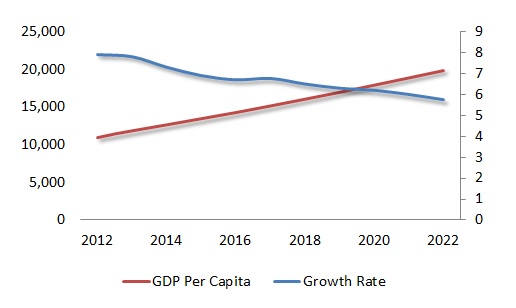China's move toward sustainable economic growth
- By Dan Steinbock
 0 Comment(s)
0 Comment(s) Print
Print E-mail China.org.cn, March 9, 2018
E-mail China.org.cn, March 9, 2018

The landscape of Yujiapu Finance District is seen at Binhai New Area of the China (Tianjin) Pilot Free Trade Zone in north China's Tianjin Municipality, Sept. 17, 2017. [Photo/Xinhua]
In his annual Government Work Report, Chinese Premier Li Keqiang said on Monday that China aims to expand its economy by 6.5 percent this year, the same rate seen in 2017.
However, numbers do not tell the full story. In the past, credit growth was nearly two times the growth rate. Now the government's attention has shifted to higher-quality growth exemplified by rising per capita incomes, eradication of poverty and the battle against climate change.
Decelerating growth, rising incomes
Barely a decade ago, China still enjoyed double-digit growth, but today that growth is slowing, a historically normal pattern in industrializing economies.
At the same time, rapidly-rising living standards are supporting thriving consumption. This trend is illustrated in the first term of President Xi Jinping and Premier Li Keqiang and a projection of their next five years, assuming current trends and peaceful conditions prevail (Figure 1).
Figure 1China's Growth Rate and Per Capita Income, 2012-2022

(Growth rate: GDP, constant prices, percent change. Per capita income: GDP per capita, constant prices (purchasing power parity; 2011 international dollars). Source: IMF/WEO.)
Between 2012 and 2022, the Chinese growth rate is expected to decelerate from 7.9 percent to 5.8 percent. Despite deceleration, however, living standards will double. In 2012, Chinese GDP per capita income was about US$11,000 and by 2022, it may increase to US$20,000. That means that per capita incomes in China are likely to grow by 6.7 percent, more than four times the U.S. figure over the same period.
In other words, the "high-speed" growth of the past, typical during intensive industrialization, is morphing into "high-quality" growth.
Combatting abject poverty on a historic scale
President Xi Jinping's idea of the "Chinese Dream" is predicated on greater focus on quality and equality of development. In the coming years that is likely to mean investments in social equity to reduce uneven coverage of pension and health insurance nationwide and improve public services.
It is also likely to translate to rejuvenation of rural areas, increased spending on high school education and vocational training, affordable housing and extended rural land leases, and an aggressive push to eradicate poverty.
In his report, Li said the government would seek to lift a further 10 million Chinese out of poverty in 2018, adding to the 68 million already elevated over the past five years (Figure 2). The progressive eradication of poverty on this scale sets a world-historical milestone.
Figure 2Lifting People from Poverty, 2000-2018 (in millions)

(Poverty Population: Millions of people living on less than 2,300 yuan ($362) in real terms in 2010. Source: China Statistical Yearbook.)
Fighting climate change: China's role in the global effort
Another key aspect of new growth is Beijing's goal to restore blue skies over the mainland by cutting pollution dramatically by 2020, coupled with efforts to attract major investors in environmental rehabilitation.
Overall, the new stress on environmental protection means advances in green manufacturing and clean energy, green finance, emissions-reduction targets and tightening environmental rules to clean up water, air and soil.
In aggregate terms, China has been the greatest polluter worldwide since the early 2010s. However, population contributes significantly to aggregate measures, so per capita figures provide a more accurate basis for international comparison, and in fact per capita emissions in China have never exceeded those in Germany and the U.S.
In the past half century, U.S. carbon dioxide (CO2) emissions have slowly decreased from more than 22 tons per capita to less than 16; in Germany, from 15 to less than 10. In China, per capita emissions spiked during the reform period, due to rapid industrialization, but levels peaked at 7.5 in the mid-2010s and are now falling (Figure 3).
Figure 3CO2 Per Capita Emissions: China, Germany and the US, 1970-2016

(CO2 tons per capita. Source: EDGAR)
In other words, even at the peak of industrialization, Chinese per capita emissions were significantly less than the corresponding U.S. and German levels. Furthermore, during the parallel phase of heavy industrialization in the U.S. and Germany, which took place a century ago, their per capita emissions were far higher relative to China's.
While it is imperative that China continue to cut emissions dramatically, the world's major advanced economies should also further reduce their own wasteful practices, which will only penalize future generations in emerging economies.
Dr Dan Steinbock is the founder of Difference Group and has served as research director at the India, China and America Institute (USA) and visiting fellow at the Shanghai Institutes for International Studies (China) and the EU Center (Singapore).
Opinion articles reflect the views of their authors, not necessarily those of China.org.cn.






Go to Forum >>0 Comment(s)